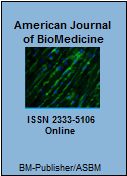
![]()
Short stature is the commonest cause of referral to a pediatric endocrine unit. The primary goal of rhGH therapy is attaining normal adult height. The objective of this study is to determine the response of children with short stature to rhGH after one year of therapy. The study were done on 110 children with short stature, their age range was 3-14 years they received regular rhGH in a dose of 0.24-0.3 mg/kg/week and their response were followed during the first year of therapy by bone age, anthropometric measurements & height velocity. Growth hormone deficiency was the leading cause of short stature contributing to 84.5%. There was significant increase in mean height velocity after one year of rhGH therapy (7.1±3.5cm per year) which is almost the double of pretreatment height velocity. The catch up growth was slow in the first 6 months of therapy and there was significant increase in bone age at the end of the first year. The lowest response in mean height velocity was in prepubertal children 3-5 years of age (1.54±0.44 cm per year). We conclude that the growth was slow during the first six months but there was significant growth at the end of the first year of therapy with doubling of the height velocity & significant increase in bone age. The response was slow in the prepubertal age.
Keywords: Response; Short stature; rhGH; Height measurements; Height velocity
Copyright © 2020 by kadhum.
- Richmond E, Rogol AD. Current indications for growth hormone therapy for children and adolescents. Endocr Dev 2010;18:92-108. [PubMed]
- Ranke MB, Lindberg A. Predicting growth in response to GH hormone treatment. Growth hor. IGF research 2009;19:1-11. [PubMed]
- Cohen P, Bright GM, Rogol AD. Effect of dose & gender on the growth & growth factor response to growth hormone in growth hormone deficient children implications for efficacy & safety. J Clin Endocrinol Metab 2002;87:90-8. [PubMed]
- Reiter EO, Price DA, Witton P, Albertsson W. Effect of GH treatment on the near final height of 1258 patients with idiopathic GHD: analysis of a large international data base. J clin Endocrinol Metab 2006;91:2647-45. [PubMed]
- Ranke MB, Lindberg A, Price DA, et al. Reiter EO: KIGS International board. Age at growth hormone therapy start & first year responsiveness to GH are major determinants of height outcome in idiopathic short stature. Hom Res 2007;68(2):53-6. [PubMed]
- Jawa A, Riaz SH, Khan A, sir MZ, Afreen B. Causes of short stature in Pakistani children found at an endocrine center. Pak. J Med sci 2016;32(6):1321-1325. [PubMed]
- AL-Ruhaily AD, Malabu UH. Short stature in Saudi Arabia: etiologic profile in adult endocrine clinic. Niger J Med 2009;18(3):268-71. [PubMed]
- Ganavi R, Jaishree V. Clinical and etiological profile of children with pathological short stature. int J Contemp pediatr 2017;4(1):73-77. [Abstract/Full-Text]
- Eckhard S, Frank W, Frank R, et al. A new and accurate prediction model for growth response to growth hormone treatment in children with growth hormone deficiency. European J. of endocrinology 2001;144:13-20. [Abstract/Full-Text]
- Voss LD. Can we measure growth?Journals of medical screening 1995;2:164-167. [Abstract/Full-Text]
- Agnieszka Z, Wioletta L, Urszula T, Agieszka M. The influence of selected factors on the effectiveness of rhGH replacement therapy in children with growth hormone deficiency. Endokrynol. ped 2014;4(49):19-26.
- Rekers-Mombarg LT, Kamp GA, Massa GG, Wit JM. Influence of growth hormone treatment on pubertal timing and pubertal growth in children with idiopathic short stature. Dutch Growth Hormone Working Group. J Pediatr. Endocrinol Metab 1999;12(5):611-22. [PubMed]
- Kamp GA, Waelkens JJ, de Muinck Keizer-Schrama SM, et al. High dose growth hormone treatment induces acceleration of skeletal maturation and an earlier onset of pubertal children with idiopathic short stature. Ach Dis Child 2002;87(3):215-220. [PubMed]
- Nagwa AM, Nermeen SE M, Fatma A, Tarek MF. Bone age is the best predictor of growth response to recombinant human growth hormone in Turner syndrome. Indian journal of human genetics 2010;16(3):119-26. [PubMed]
- Schonau E, Westermann F, Rauch F, et al. A new and accurate prediction model for growth response to growth hormone treatment in children with growth hormone deficiency. Eur J Endocrinol 2001;144(1):13-20. [Abstract/Full-Text]
- Ireno L, Allessandro M, Silvia V, et al. Predictors of response to rhGH treatment in 125 children with short stature with various etiologies. European society of pediatrics endocrinology abstracts 2015;84:3-951. [Abstract/Full-Text]
Who Can Become a Reviewer?
Any expert in the article's research field can become a reviewer with American Journal of Biomedicine. Editors might ask you to look at a specific aspect of an article,...
Thank you for visiting American Journal of BioMedicine. * = Required fields
Error: Contact form not found.
How to cite this article
kadhum RJ. Response of children with short stature to recombinant human growth hormone (rhGH) after the first year of therapy" style. American Journal of BioMedicine 2020;8(2):112-118.
Article outline
1. Abstract
2. Keywords
3. Introduction
4. Methods
5. Results
6. Discussion
7. References
Journal Metrics
Journal TOCs SpotiDoc Publons
Google Scholar CiteSeerx Crossref
Author Services Portal
Submission Guidelines
Submit Your Paper
Supports Open Access
Track Your Article
Video abstracts
CME
Image challenge



